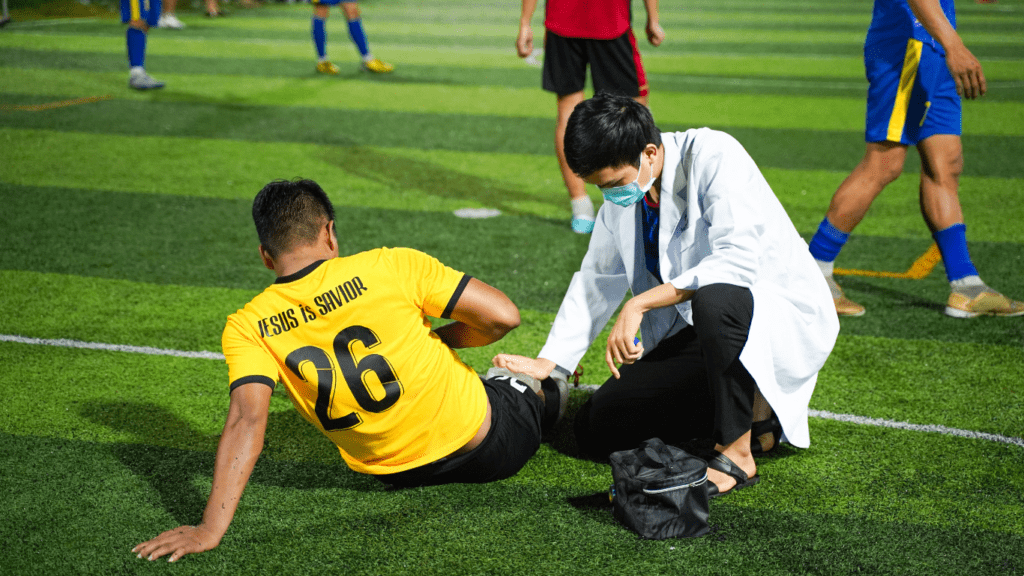The Importance Of Injury Prevention
Injury prevention isn’t just a safety measure—it’s essential for maintaining long-term well-being. By taking preventative steps, athletes can reduce the risk of accidents that could sideline them for weeks or even months. For example, consistent warm-ups and cool-downs improve flexibility and circulation, aiding in muscle recovery. Proper gear, such as helmets in contact sports, minimizes the severity of head injuries.
Reducing the likelihood of injuries has another significant benefit. It allows individuals to maintain consistent participation in their chosen sport, leading to better skill development over time. For instance, runners who include strength training in their routines avoid common issues like shin splints and knee problems, thus enhancing their endurance and performance.
Furthermore, injury prevention contributes to mental health. Knowing that you’re protected from preventable injuries can boost your confidence and reduce anxiety. When athletes feel secure, they perform better and enjoy their activities more. This psychological edge can make a big difference in competitive settings.
Lastly, injury prevention saves on medical costs. Treating injuries can be expensive, involving hospital visits, physical therapy, and sometimes surgery. By investing time in proper training and equipment, individuals avoid these unnecessary expenses, making injury prevention a financially smart strategy.
Common Sports Injuries
Understanding common sports injuries helps in taking proactive measures to avoid them. Here are some prevalent injuries that athletes encounter.
Sprains And Strains
Sprains and strains often occur in sports involving sudden movements or changes in direction, such as basketball and soccer. Sprains affect the ligaments, which connect bones at the joints. A common example is an ankle sprain due to a twisted foot. Strains impact muscles or tendons, which connect muscles to bones. A frequent example is a hamstring strain in runners.
Fractures
Fractures, or broken bones, are severe injuries resulting from high-impact sports like football or hockey. They range from hairline to compound fractures, where the bone breaks through the skin. Wrist and collarbone fractures are common in contact sports and falls, occurring when athletes land awkwardly or experience direct blows.
Concussions
Concussions are brain injuries caused by a blow to the head, prevalent in sports like football, rugby, and boxing. They disrupt brain function, leading to symptoms like headaches, dizziness, and confusion. Concussions need immediate medical attention to prevent long-term damage. Preventive measures, such as wearing helmets, help reduce the risk of concussions.
Warm-Up And Stretching
Warm-up and stretching routines play critical roles in injury prevention. They prepare your body for physical activity and enhance performance.
Benefits Of Warm-Up Exercises
Warm-up exercises increase blood flow, elevate muscle temperature, and improve flexibility. These actions reduce stiffness and lower the risk of pulls and strains. Warm-ups also prepare the cardiovascular system for exertion, thus optimizing performance levels. By gradually increasing heart rate, they ensure a smooth transition to intense activity.
Effective Stretching Techniques

Dynamic stretching is ideal before activities. It involves movements like leg swings, arm circles, and torso twists, which increase muscle elasticity and joint mobility. Static stretching, where you hold a stretch for 15-30 seconds, is best post-exercise when muscles are warm. Techniques like the hamstring stretch or calf stretch improve flexibility and aid recovery.
Proper Equipment And Gear
Using the right equipment and gear can significantly reduce the risk of injuries while playing sports. It’s essential to make informed choices and maintain everything in good condition.
Choosing The Right Equipment
- Select the appropriate equipment for your sport. Helmets, knee pads, and mouthguards can protect against head and joint injuries.
- Football players need helmets with proper cushioning, while skateboarders must use knee and elbow pads to minimize impact injuries.
- Ensure all equipment fits well; loose or tight gear can lead to discomfort and potential accidents.
- Inspect the quality and certification of gear before purchase.
- Look for safety standards approval from organizations like ASTM International or the National Operating Committee on Standards for Athletic Equipment (NOCSAE). High-quality gear often lasts longer and offers better protection.
Maintaining Your Gear
Regularly check and maintain your equipment. Helmets should be free from cracks, and padding should remain firm. Replace worn-out or damaged items immediately to ensure optimal safety.
Clean and store gear properly after every use. For instance, moisture can degrade materials over time, so drying off equipment before storage helps. Refer to manufacturer guidelines for specific maintenance tips, like how to clean mouthguards or wash fabric pads, to extend their lifespan and ensure you stay safe during activities.
Techniques And Form
Proper techniques and form are essential to prevent injuries while playing sports. Implementing correct movements and practices can significantly reduce the risk of musculoskeletal issues and enhance overall performance.
Learning Proper Techniques
Learning proper techniques is crucial for injury prevention. Each sport has specific movements and skills that, if performed incorrectly, can lead to injuries. For instance:
- Running: Adopting a correct running form can prevent shin splints and knee pain. Keeping the torso upright, arms at a 90-degree angle, and landing mid-foot rather than heel can mitigate impact stress.
- Weightlifting: Using the right lifting techniques helps avoid strains and muscle tears. Maintaining a neutral spine, engaging the core, and lifting with the legs instead of the back ensures safer workouts.
- Swimming: Proper swimming strokes reduce shoulder injuries. Practicing the correct arm rotation, breathing techniques, and body positioning contributes to efficient and safe swimming.
Seeking instruction from qualified coaches or trainers can ensure that techniques are learned and executed correctly.
Avoiding Overuse Injuries
Avoiding overuse injuries involves balancing activity levels and allowing for adequate recovery. Overuse injuries often result from repetitive stress on specific body parts without sufficient rest. Examples include:
- Tendinitis: Often affecting the knees, elbows, or shoulders, tendinitis arises from repetitive motions. Diversifying exercise routines and incorporating rest days can prevent this.
- Stress Fractures: Common in high-impact activities like running, stress fractures occur when bone repair can’t keep up with repeated stress. Gradual intensity increases and cross-training can reduce occurrences.
- Runner’s Knee: Caused by repetitive impact on the knee joint, this condition can be mitigated by strengthening surrounding muscles and ensuring proper footwear.
Listening to the body and recognizing early signs of overuse helps manage and prevent chronic conditions.
Rest And Recovery
Rest and recovery play a crucial role in preventing sports injuries. They allow the body to heal, rebuild, and strengthen.
Importance Of Rest Days
Rest days are vital for injury prevention. Muscles recover and grow during rest, not during activity. Ignoring rest days can lead to overuse injuries such as tendinitis and stress fractures. An effective rest schedule might include at least one full day off from intense activity each week.
Effective Recovery Practices
Effective recovery practices enhance muscle repair and reduce injury risk. Techniques include active recovery, like light jogging or cycling, to maintain blood flow. Stretching post-activity increases flexibility and reduces muscle tightness. Hydration and nutrition, focusing on protein and electrolyte intake, support muscle repair and overall recovery. Using tools like foam rollers can alleviate muscle soreness and improve tissue health. Prioritizing sleep ensures the body undergoes the necessary repair processes, promoting overall recovery.


 David Boyd brought valuable insights to News Flip Network, contributing his knowledge in business and technology. His work on streamlining the site’s interface and optimizing backend processes ensured that the platform operates efficiently. Boyd's efforts in integrating advanced tools and managing technical aspects played a significant role in the site's reliable and timely news delivery.
David Boyd brought valuable insights to News Flip Network, contributing his knowledge in business and technology. His work on streamlining the site’s interface and optimizing backend processes ensured that the platform operates efficiently. Boyd's efforts in integrating advanced tools and managing technical aspects played a significant role in the site's reliable and timely news delivery.